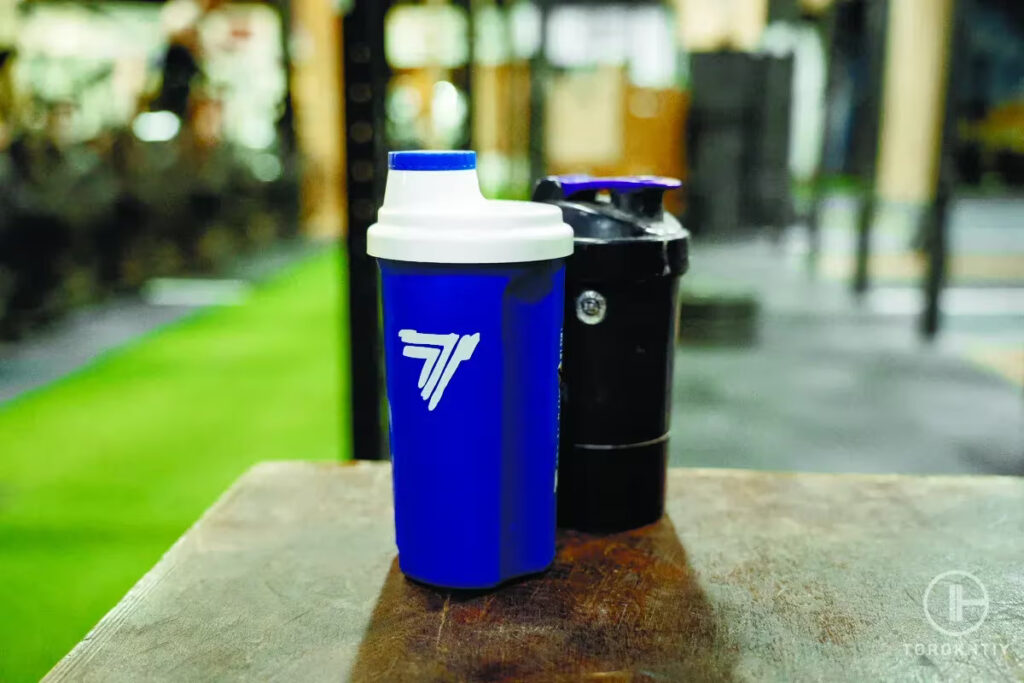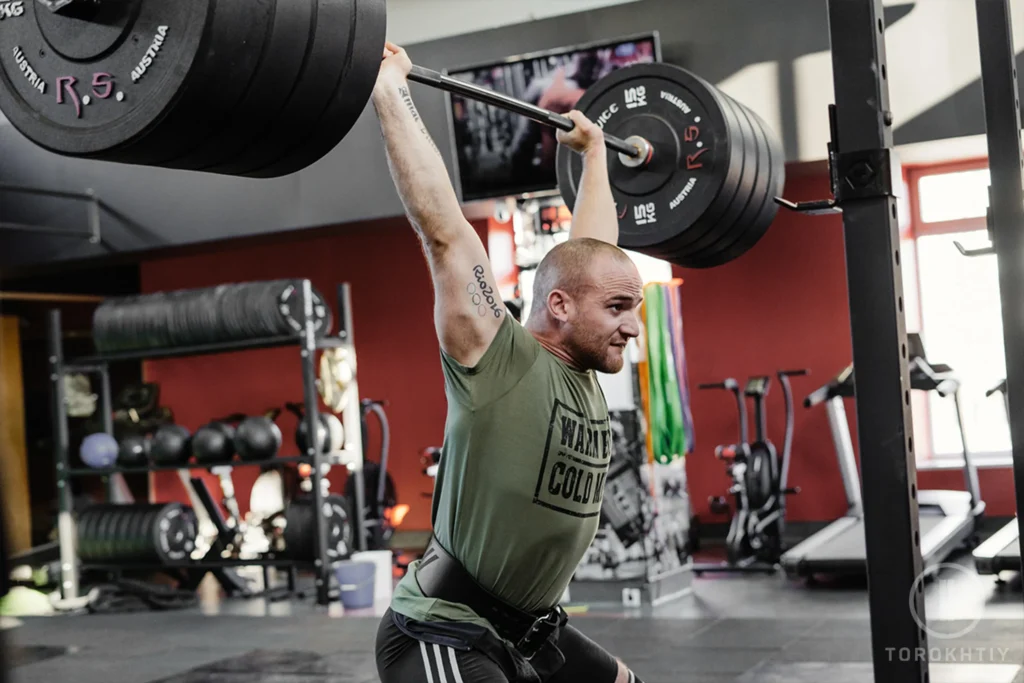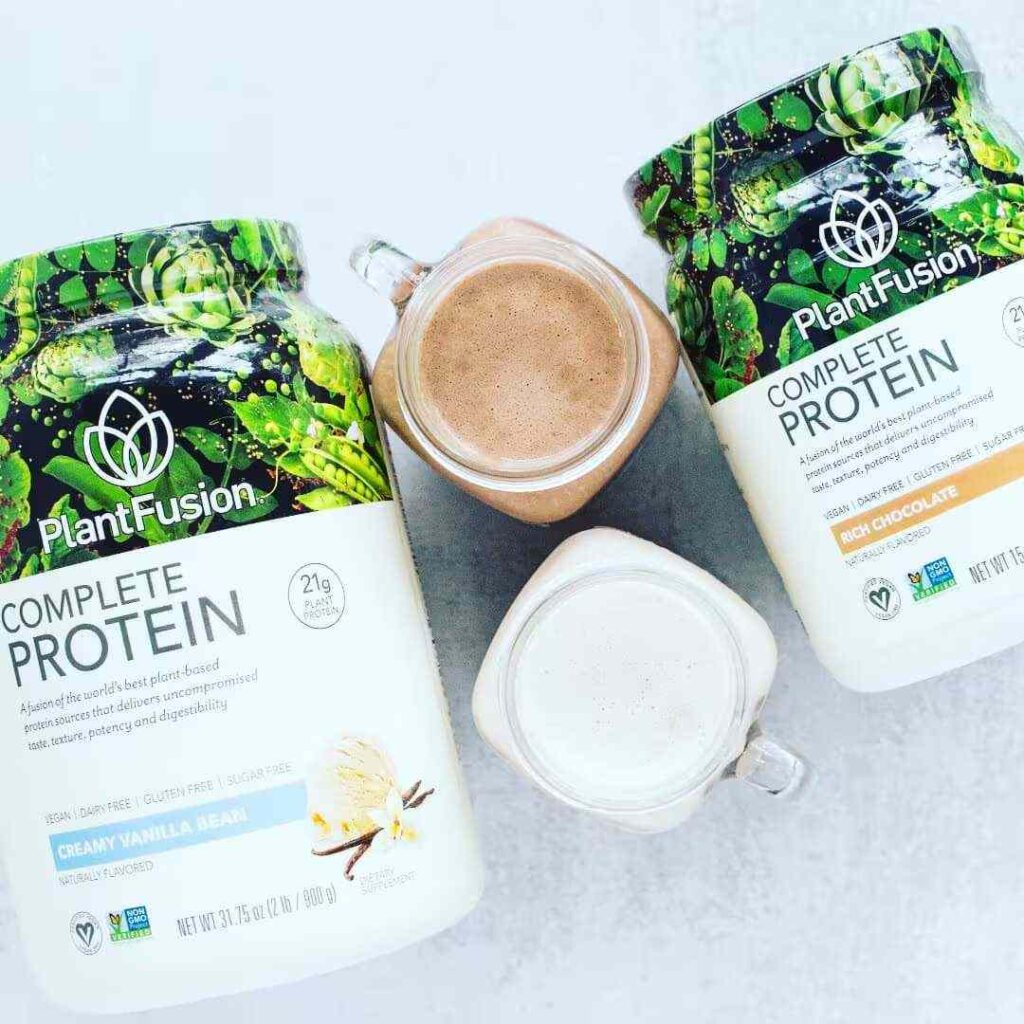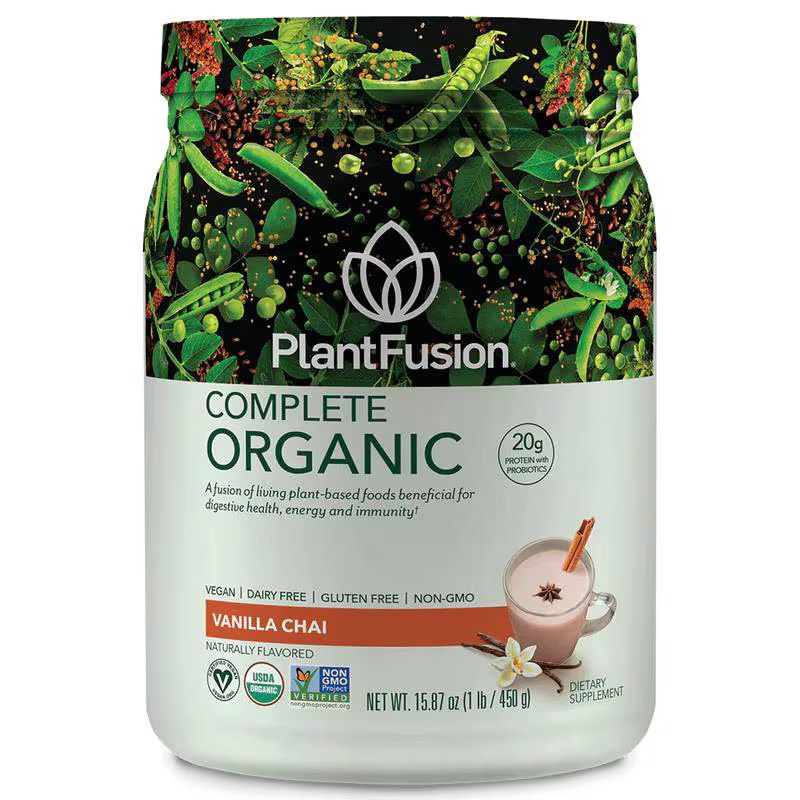How to Make Protein Shakes Taste Better: 8 Hacks
Protein powder can be a convenient method to achieve your protein requirement, but some individuals may feel that protein powder tastes bad and not all powders have an appealing taste when consumed on their own.
In this post, we will explore some strategies for how to make protein shakes taste better, examine the reasons behind unpleasant protein powder tastes, and provide guidance on what ingredients are suitable or unsuitable to mix with protein powder.
How to make protein shakes taste better? To improve the flavor and appeal of protein shakes, try to add milk or yogurt alternatives, fruits, flavored protein powder, sweeteners, spices, or healthy fats such as nut or seed butters. You could also experiment with using a blender with or without ice to create a smoother consistency.

Hacks for Making Protein Shakes Taste Better
1. Use a Blender
This can mechanically help create a smoother and more enjoyable texture. Blenders are quick and efficient, making it easy to whip up a protein shake in just a few minutes. This is particularly useful if you’re short on time and need a quick and easy meal or snack.
They can be used to make a wide range of protein shake variations. Below we will cover some ingredients you can to create a customized protein shake that suits your taste preferences and dietary needs. You can also add ice cubes to make a refreshing, thicker, and creamier protein shake.
2. Choose a Flavored Protein Powder
Many brands of protein powder come in a variety of flavors, such as chocolate, vanilla, and strawberry. Experiment with different flavors to find one you enjoy.
3. Milk or Milk Alternatives
If you are wondering how to make protein powder taste less chalky, there’s a simple solution to make your shakes smoother and creamier. Mix in milk or milk alternatives such as almond or oat milk to add creaminess. Unflavored versions may go well with vanilla protein powders as these can taste quite sweet.
Therefore, if you are wondering how to make vanilla protein shakes taste better, the liquid can dilute the strong sweet flavor of vanilla protein powders. Yogurt can add creaminess. Greek yogurt, in particular, is high in protein. Some yogurt products are also a good source of probiotics.

4. Nut or Seed Butters
Nut or seed butters that use roasted ingredients can add an appetizing aroma and source of healthy fat to the shake.
5. Avocados
Avocados offer a neutral flavor and contribute healthy fats and fiber to the mix. Cut the avocado in half and remove the pit. Scoop out the flesh and add it to your blender. Avocados can also be combined with other fruits or vegetables to create a delicious and nutritious smoothie.
Consider adding spinach or kale for an extra dose of greens, or berries for a sweet and fruity flavor. Get creative and experiment with different combinations to find your perfect avocado protein shake!
6. Other Fruit and Vegetables
Fruits can add natural sweetness and vegetables can provide additional fiber, antioxidants, vitamins, and minerals without compromising taste. If you have a chocolate protein powder and it is too strong in flavor, a good way for how to make chocolate protein shake taste better would be to balance the more bitter cocoa flavor with a sweeter flavor such as a banana.
7. Spices
Spices such as cinnamon or nutmeg can add flavor to your protein powder without adding calories. You can also try adding a dash of vanilla extract or cocoa powder for a richer flavor.
8. Sweeteners
If you have an unflavored powder and are wondering how to make unflavored protein taste good, you could add a natural sweetener such as honey or maple syrup.
Why Does Protein Powder Taste So Bad?
Although protein powder manufacturers strive to create blends with delicious flavors and textures, personal taste preferences can vary widely. As a result, there is a possibility that you may not enjoy the taste of certain flavors or may wish to modify them to achieve a more satisfying experience.
In general, some possible reasons of unpleasant taste are:

1. Low-Quality Ingredients:
Some protein powders may be made with lower quality ingredients, such as low-quality whey protein or artificial sweeteners, which can affect the taste.
2. Unflavored or Unsweetened Powders:
Unflavored or unsweetened protein powders tend to have a more bitter taste than flavored powders, which can make them less enjoyable to drink.
3. Rancidity
Depending on the product and other ingredients that may be in them, if there are ingredients that are sources of fat such as seeds, over time these can become oxidized and rancid, which can give the powder a bad taste and smell.
4. Texture
Some powders, typically plant-based protein powders such as pea protein, can be gritty and chalky due to the higher carbohydrate and fibre plant protein sources. The various ‘hacks’ covered above can be helpful if you are wondering how to make pea protein taste better.
Complete Organic Protein Organic Vegan Protein Powder
Finding a plant-based protein powder that is both tasty and nutritious can be challenging. While people may prefer plant-based protein sources for ethical, health, or environmental reasons, some find it difficult to enjoy the taste of certain plant-based protein powders.
If you’re having trouble with the taste or texture of your plant-based protein, try the tips above. Alternatively, consider our recommendation: the Complete Organic Protein Organic Vegan Protein Powder, which is suitable for building muscle and recovery as it contains 130kcal and 20g protein per 1 scoop serving.
It is also an excellent source of iron, containing 4mg per 1 scoop serving, which is 22% of the daily value for an average adult. Iron is an essential mineral that plays a crucial role in the body, including the production of red blood cells and transportation of oxygen to different parts of the body.
For vegetarians, getting enough iron can be a concern because the body absorbs iron from plant sources less efficiently than from animal sources.
Another important consideration for plant proteins is a balanced amino acid composition. This Plant Fusion protein powder is a blend of pea protein isolate, sprouted amaranth, sprouted quinoa, and flaxseed. Pea protein is relatively low in some essential amino acids, particularly methionine and cysteine.
Methionine is an essential amino acid that is important for tissue growth and repair, while cysteine is involved in the formation of antioxidant molecules and the synthesis of important proteins.
When combined with a complementary protein source it can ensure that all essential amino acids are being met. A complementary protein source for pea protein would be something that is higher in methionine and cysteine such as quinoa, which this product contains.
This product also contains some sprouted ingredients such as sprouted amaranth and sprouted quinoa. Sprouted foods may be easier to digest for some people than their non-sprouted counterparts.
When a seed, nut, or grain is sprouted, it begins to break down the complex carbohydrates, proteins, and fats that are present in the food. This process can make these nutrients easier to digest, and may also increase the availability of certain vitamins and minerals.
Sprouted foods may also contain lower levels of certain anti-nutrients, such as phytic acid and lectins, which can bind to minerals and make them less available for absorption in the body. Sprouting can help to reduce the levels of these anti-nutrients, which can increase the bioavailability of minerals like iron, zinc, and calcium.

However, it is important to note that the extent to which sprouted foods are easier to digest can vary depending on the individual and the specific food in question. Some people may still experience digestive discomfort or intolerance to sprouted foods, particularly if they have underlying digestive issues or allergies.
Despite this, the product also contains two enzymes that are commonly used as digestive aids in dietary supplements. For some people, this may improve the digestibility of the product. Alpha-galactosidase is an enzyme that helps to break down complex carbohydrates. Bromelain is a proteolytic enzyme, which means that it helps to break down proteins.
It is derived from pineapple stems and is often used as a digestive aid due to its ability to help break down protein molecules in the digestive tract.One serving of this product contains 100mg of alpha-galactosidase and bromelain combined.
It is not known how much of each enzyme there is and therefore, difficult to say whether this amount is adequate to truly aid digestion. However, reviewers of the product have indicated good digestibility.
And for dessert, the taste! The product contains two flavors, “vanilla chai” and “rich chocolate”. It has a rating of 4.85/5 based on 41 reviews online. People report enjoyment of the two flavors, satisfaction with incorporating into different recipes, no GI side effects, appropriate for someone with digestive issues, and helps to meet protein needs on a plant-based diet.
FAQ
Do Protein Shakes Taste Better With Milk or Water?
Whether or not protein shakes taste better with milk or water is subjective to personal preferences and goals. If you prefer a smoother, creamier texture, then milk or milk alternatives can help achieve this meanwhile providing extra calories and protein as well as calcium and vitamin D if the product is fortified.
If you simply need a liquid as a carrier for your protein powder and do not want to add more calories into your day, then water can be a good option. An in-between option could be to mix protein powder with a combination of milk and water to balance the creaminess and calorie count.
It is also possible to choose an unflavoured milk alternative product as these are often low calorie and can still add creaminess to a protein shake.
What Is the Best Thing to Mix With Protein Powder?
Similarly to the above, the “best” ingredients to mix with protein powder depends on your preference and goals. If you are looking to pack more nutrients into one sitting, then a protein shake could help achieve this by making a smoothie with protein powder and adding more ingredients such as nut butter for healthy fats and fruits for carbohydrates and antioxidants.
You could also add liquid supplements such as liquid vitamin D3 or omega-3 if you find it difficult to get these nutrients in your diet otherwise and prefer liquid forms of supplements. Vitamin D3 is important for bone health and immunity while omega-3 fatty acids have beneficial anti-inflammatory properties.
Keep in mind that some omega-3s have a fishy flavor, which doesn’t go well with a protein shake, but there are neutral flavors available you could choose from.
What Should You Not Mix With Protein?
Some ingredients that should not be mixed with protein powder include acidic and carbonated ingredients. Acidic liquids such as citrus juice can cause the protein to denature and clump together, resulting in a lumpy texture and an unpleasant taste. Carbonated beverages can cause bloating and stomach discomfort due to the gas that is released when the two are mixed.
Conclusion
We explored the reasons you might be wondering, ‘why do protein shakes taste so bad?’ and shared tips for how to make protein powder taste good. We also discussed what to do with protein powder you don’t like and offered suggestions on flavoring for protein shakes.
We’d love to hear your thoughts on how you mix your protein powder and any techniques you’ve used to improve the taste of protein powder that you didn’t enjoy. Please share your experiences in the comments section below!
Also read:
- Why Is Protein Powder So Expensive
- How Long Does It Take To Absorb Protein
- Protein Powder vs Amino Acids
- Can You Put Protein Powder in Cereal
- How Long Do Protein Shakes Last
- Best Protein Powder for Senior
- What Do You Mix Protein Powder With
- Whey Protein vs Isolate
- Best Supplements for Muscle Soreness
References:
- Iron – Health Professional // Ods: http://surl.li/gpwlf
- Protein content and amino acid composition of commercially available plant-based protein isolates // Ncbi: https://www.ncbi.nlm.nih.gov/pmc/articles/PMC6245118/
- The role of methionine on metabolism, oxidative stress, and diseases // Researchgate: http://surl.li/gpwli
- Effects of the Usage of l-Cysteine (l-Cys) on Human Health // Ncbi: https://www.ncbi.nlm.nih.gov/pmc/articles/PMC6017824/
- Physicochemical and functional properties of quinoa protein isolate // Sciencedirect: https://www.sciencedirect.com/science/article/pii/S0570178315000433
- Sprouted Grains: A Comprehensive Review // Ncbi: https://www.ncbi.nlm.nih.gov/pmc/articles/PMC6413227/
- The Effect of Oral α-Galactosidase on Intestinal Gas Production and Gas-Related Symptoms // Springer: https://link.springer.com/article/10.1007/s10620-006-9296-9
- Properties and Therapeutic Application of Bromelain: A Review // Ncbi: https://www.ncbi.nlm.nih.gov/pmc/articles/PMC3529416/
- Vitamin D and the Immune System // Ncbi: https://www.ncbi.nlm.nih.gov/pmc/articles/PMC3166406/
- Omega-3 fatty acids in inflammation and autoimmune diseases // Pubmed: https://pubmed.ncbi.nlm.nih.gov/12480795/
Why Trust Us?
With over 20 years in Olympic Weightlifting, our team does its best to provide the audience with ultimate support and meet the needs and requirements of advanced athletes and professional lifters, as well as people who strive to open new opportunities and develop their physical capabilities with us.
By trusting the recommendations of our certified experts in coaching, nutrition, dietology, and sports training programming, as well as scientific consultants, and physiotherapists, we provide you with thorough, well-considered, and scientifically proven content. All the information given in the articles concerning workout programming, separate exercises, and athletic performance, in general, is based on verified data. We ensure that you can rely on our professionals’ pieces of advice and recommendations that can be treated as personalized ones which will benefit you and fully meet your needs.
The product testing process is described in more detail here
Author: Oleksandr Maksymenko
Certified Sports Nutritionist,
MSc Sports Dietetics
Specializing in: Weight management, Fitness / Sports nutrition
Oleksandr is a professional fitness nutritionist certified by the Fitness Professional Association (FPA). He follows the principles of evidence-based dietetics and fosters a healthy relationship with food in his clients, ensuring there are no strict prohibitions on their favorite foods or frequent lapses. His primary goal is not only to achieve results for you but also to sustain them over the long term, all while enjoying tasty and delicious food.







